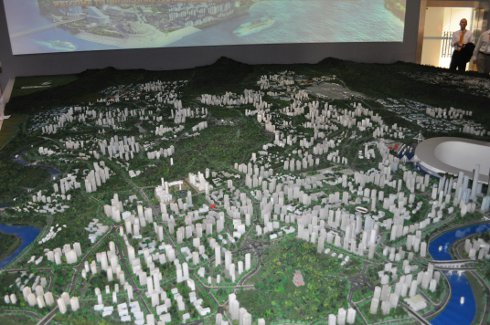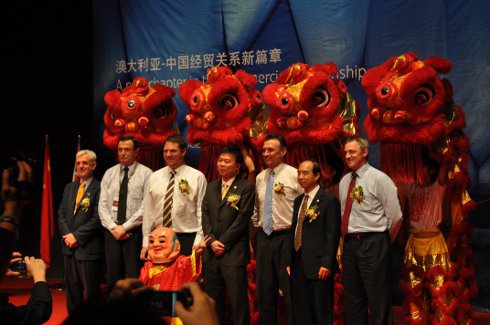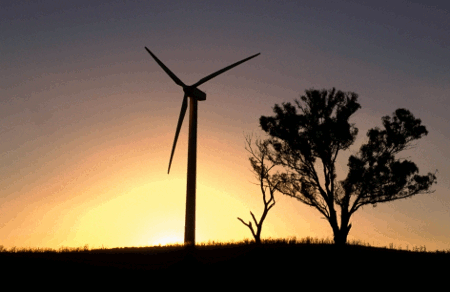
|
Published: 5 September 2011
Business leaders review Asia’s green growth milestones
Asian countries and companies are activating broad sustainable development commitments in their pursuit of robust low-carbon economies. Australian industry and business leaders have recently been reviewing Asia’s progress.

|
|
A model of Chongqing city, one of many new ‘greener’ urban centres in China, currently halfway through construction.
Credit: Prof. Ray Wills
|
In Canberra last June, the 12th National Business Leaders Forum on Sustainable Development showcased Asia’s significant investment in ‘green’ economic growth strategies, and discussed how Australia will remain competitive by following suit. China, South Korea, Japan, Indonesia and India are all investing in significant degrees to reduce carbon risk and other environmental impacts through innovation, while driving greater economic viability.
China already wants to produce 16 per cent of its primary energy renewably by 2020. The technology pathways to China’s goal are set out in its recent 12th five-year plan, which was discussed at the Forum. Korea has a comprehensive policy and investment framework for green growth in its 2009–13 five-year plan, and Japan is aiming for a 50-trillion Yen ‘green tech’ market, with 1.5 million new environment-related jobs in its National Strategic Projects related to green innovation.
These initiatives directly relate to pathways for environmentally sustainable economic growth detailed by the Organisation for Economic Co-operation and Development (OECD) in May in its Towards Green Growth strategy report. The strategy was developed after the treasury ministers of 34 member nations asked the OECD in 2009 to find new ways of sustainable growth out of the debt mire of the global financial crisis.
Business and industry leaders at the Forum were presented with an astute synthesis of the Towards Green Growth research by Director of the OECD’s Environment Directorate, Mr Simon Upton. Key messages were that business-as-usual economic growth is degrading key pillars of the environmental and financial systems that support us; carbon pollution is a key risk; and new ‘clean’ ways of operating and developing are proving feasible. At the same time, these new approaches reduce the impact on natural capital and spur economic expansion – helping decouple environmental impact from growth.
Mr Upton showed how these new pathways provide incentive for investment and innovation in ‘green’ and ‘smart’ technologies, and centralise ‘pricing-in’ carbon pollution to reduce it. What results is a transition to a cleaner economy, and an increase in productivity.
The OECD research – unanimously welcomed by finance ministers – also describes how the process can simultaneously help support developing nations’ progress, and the United Nations Millennium Development Goals.
‘Just focusing on GDP is not enough; the environmental and social asset base now needs to be factored in as well,’ said Mr Upton. ‘From next year on, the Green Growth Strategy will be integrated into the OECD’s major assessments of country GDP [gross domestic product] and recommendations.’
This holistic approach is exemplified by numerous case studies in the book Cents and Sustainability, also launched at the conference. Lead author, Dr Mike Smith, is from the Australian National University’s Fenner School.
‘Decoupling environmental impact from GDP while generating business innovation and strong productivity is the magic of green growth,’ said Dr Smith.
Delegates at the Forum discussed how green growth opportunity can be seized and driven by commitments from individual industries and companies, and that the rewards are significant. The keynote presentation by Mr Kishor Chaukar, Managing Director of TATA Industries India, showed how the company had grown turnover from US$7 billion to US$80 billion in 10 years by embedding sustainability measures and actively reducing its carbon footprint. The company’s approach spurred internal commercial innovation and widened community trust.
The Wall Street Journal recently cited KPMG research giving India the lead in Asia for renewable energy investment, a ‘recognition of the country's proactive government energy program, natural resources and mushrooming swathe of entrepreneurs’.
Convenor of the Forum, Ms Molly Harriss Olson, said: ‘One of the striking features of this year’s Forum was that Australian business affirmed the findings of the OECD’s report that implementing a market-based approach to carbon was necessary to maintain and grow a prosperous and sustainable economy.’
The Forum also underlined the intentions of the government’s proposed Clean Energy Future legislation: that for robust progress, carbon pricing must be supported by complementary measures that improve consumption efficiency and address market barriers to investment in ‘clean tech’ innovation.
More information




